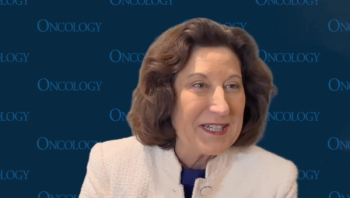
Oncology NEWS International
- Oncology NEWS International Vol 8 No 7
- Volume 8
- Issue 7
Breast Cancer Survivors at Increased Risk for Ovarian Cancer
SAN FRANCISCO-Women who have survived breast cancer are at increased risk for subsequent ovarian cancer, and this risk is especially high in women diagnosed with breast cancer before age 50 and in African-American, Asian, and Hispanic women, according to data presented at the 30th Annual Meeting of the Society of Gynecologic Oncologists.
SAN FRANCISCOWomen who have survived breast cancer are at increased risk for subsequent ovarian cancer, and this risk is especially high in women diagnosed with breast cancer before age 50 and in African-American, Asian, and Hispanic women, according to data presented at the 30th Annual Meeting of the Society of Gynecologic Oncologists.
Minorities Have Higher Rates
Wendy R. Brewster, MD, and her colleagues from the University of California, Irvine, found relative risks (RRs) for ovarian cancer in women diagnosed with breast cancer before age 50 of 1.79 for non-Hispanic white women, 2.38 for African-American women, 2.86 for Asian women, and 3.95 for Hispanic women.
We often think of breast cancer as a disease of Caucasian women, Dr. Brewster said in an interview. When you see such high rates of subsequent ovarian cancer in Asian and Hispanic women, it raises the question of a possible genetic susceptibility. She pointed out that there has been little work on genetic susceptibility in African-American, Asian, or Hispanic women.
The analysis, based on data from the Surveillance, Epidemiology and End Results (SEER) database, included 120,380 women with breast cancer. Patients were stratified by age at diagnosis of breast cancer, stage of breast cancer and race/ethnicity. Ovarian cancer as a subsequent primary malignancy was diagnosed in 478 of these women. The overall relative risk of ovarian cancer after a diagnosis of breast cancer was 1.30.
Risk was significantly elevated in women diagnosed with breast cancer before age 50 (RR 1.93). The largest increased risk of ovarian cancer was in women diagnosed with breast cancer between the ages of 15 and 39 (RR 3.21).
Women age 50 or less at diagnosis of stage I/II breast cancer had a higher relative risk of ovarian cancer than those diagnosed with more advanced breast cancer at the same age (2.24 vs 1.52, P < .05). Stage did not influence risk in postmenopausal women.
The most immediate implication of her research pertains to how patients are counseled. Patients do not so commonly die from breast cancer now, she said. We find it in earlier stages. Ovarian cancer is a much more lethal disease, and a higher percentage of women with ovarian cancer die, partly because it is not detected early. We still do not have a good screening tool for ovarian cancer.
The main options for high-risk women are triple screening for those who want to retain childbearing ability, or removal of the ovaries. If you are younger, a lethal disease portends a much shortened life, compared with developing the same disease decades later, Dr. Brewster noted.
Ovariectomy or more intensive screening should be considered, she said, and this may require a shift in the patients health emphasis.
Those diagnosed with breast cancer may be less concerned about having regular pelvic examinations because so much of their attention has been directed to the breast cancer, Dr. Brewster said. The patient diagnosed with breast cancer before the age of 50 and the black, Hispanic, or Asian patient with breast cancer should be counseled to have careful, regular screening due to the increased risk of ovarian cancer.
Articles in this issue
over 26 years ago
Nasal Angiogenesis Inhibitor May Stop Kaposi’s Sarcomaover 26 years ago
Surgeon’s Perspective on Neoadjuvant Chemo for Breast Cancerover 26 years ago
STAR Breast Cancer Prevention Trial Begins Enrollmentover 26 years ago
Studies Suggest New Approaches in Hereditary Ovarian Cancerover 26 years ago
Lycopene Beneficial in Prostate Cancerover 26 years ago
Komen Launches REMEMBERover 26 years ago
Advice and Support for Daughters of Breast Cancer Patientsover 26 years ago
Fetus May Be Harmed by Second-Hand Smokeover 26 years ago
Genes Linked to Smoking Affinity, Smoking-Induced Lung Cancerover 26 years ago
Ultraviolet Light Slated for Review as CarcinogenNewsletter
Stay up to date on recent advances in the multidisciplinary approach to cancer.















































































